Intel's 10nm Cannon Lake and Core i3-8121U Deep Dive Review
by Ian Cutress on January 25, 2019 10:30 AM ESTStock CPU Performance: Encoding Tests
With the rise of streaming, vlogs, and video content as a whole, encoding and transcoding tests are becoming ever more important. Not only are more home users and gamers needing to convert video files into something more manageable, for streaming or archival purposes, but the servers that manage the output also manage around data and log files with compression and decompression. Our encoding tasks are focused around these important scenarios, with input from the community for the best implementation of real-world testing.
All of our benchmark results can also be found in our benchmark engine, Bench.
Handbrake 1.1.0: Streaming and Archival Video Transcoding
A popular open source tool, Handbrake is the anything-to-anything video conversion software that a number of people use as a reference point. The danger is always on version numbers and optimization, for example the latest versions of the software can take advantage of AVX-512 and OpenCL to accelerate certain types of transcoding and algorithms. The version we use here is a pure CPU play, with common transcoding variations.
We have split Handbrake up into several tests, using a Logitech C920 1080p60 native webcam recording (essentially a streamer recording), and convert them into two types of streaming formats and one for archival. The output settings used are:
- 720p60 at 6000 kbps constant bit rate, fast setting, high profile
- 1080p60 at 3500 kbps constant bit rate, faster setting, main profile
- 1080p60 HEVC at 3500 kbps variable bit rate, fast setting, main profile

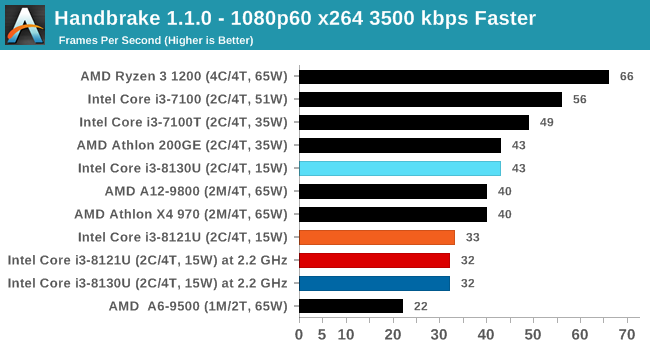
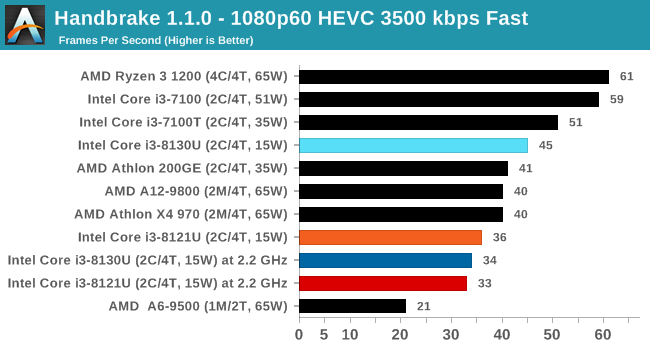
7-zip v1805: Popular Open-Source Encoding Engine
Out of our compression/decompression tool tests, 7-zip is the most requested and comes with a built-in benchmark. For our test suite, we’ve pulled the latest version of the software and we run the benchmark from the command line, reporting the compression, decompression, and a combined score.
It is noted in this benchmark that the latest multi-die processors have very bi-modal performance between compression and decompression, performing well in one and badly in the other. There are also discussions around how the Windows Scheduler is implementing every thread. As we get more results, it will be interesting to see how this plays out.
Please note, if you plan to share out the Compression graph, please include the Decompression one. Otherwise you’re only presenting half a picture.
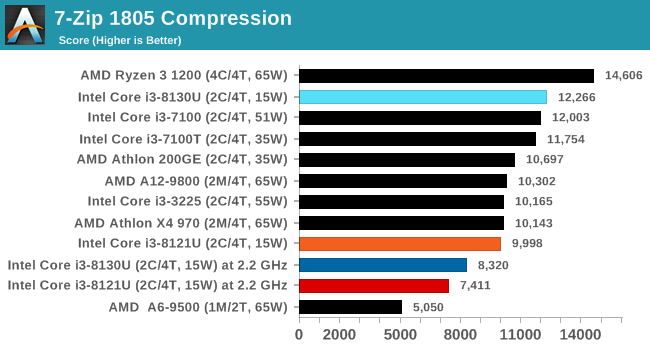


WinRAR 5.60b3: Archiving Tool
My compression tool of choice is often WinRAR, having been one of the first tools a number of my generation used over two decades ago. The interface has not changed much, although the integration with Windows right click commands is always a plus. It has no in-built test, so we run a compression over a set directory containing over thirty 60-second video files and 2000 small web-based files at a normal compression rate.
WinRAR is variable threaded but also susceptible to caching, so in our test we run it 10 times and take the average of the last five, leaving the test purely for raw CPU compute performance.
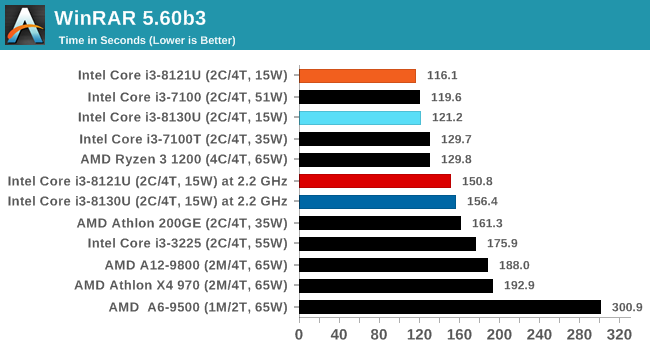
AES Encryption: File Security
A number of platforms, particularly mobile devices, are now offering encryption by default with file systems in order to protect the contents. Windows based devices have these options as well, often applied by BitLocker or third-party software. In our AES encryption test, we used the discontinued TrueCrypt for its built-in benchmark, which tests several encryption algorithms directly in memory.
The data we take for this test is the combined AES encrypt/decrypt performance, measured in gigabytes per second. The software does use AES commands for processors that offer hardware selection, however not AVX-512.
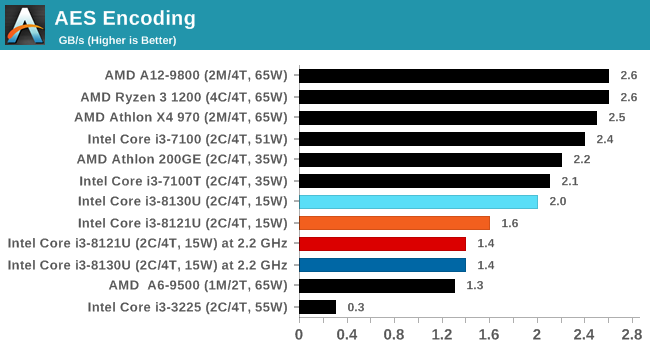










129 Comments
View All Comments
KOneJ - Sunday, January 27, 2019 - link
Bingo.Spunjji - Tuesday, January 29, 2019 - link
Truly magnificent.KateH - Saturday, January 26, 2019 - link
but please, if OP is interested in taking a whack at "articulating" i'd love to see what that looks like and how my translation faredMidwayman - Friday, January 25, 2019 - link
Interesing. So Basically no real possibility for desktop improvement until 2020 at least. They really are giving AMD a huge window to take the performance crown. Zen 2 is due to ship this year, right?BigMamaInHouse - Friday, January 25, 2019 - link
And dont forget- there are many Dual/Quad core (lets Say from Q6600 ~SandyBridge to 7700K ) Intel PC's that gonna be upgraded finally with new Ryzen launch and those PC won't we upgraded for another 3+ Years,DanNeely - Sunday, January 27, 2019 - link
The lower end of that range has been upgrading for years. The upper end has no real reason to upgrade unless they're doing something other than gaming, since current games don't benefit from the higher core counts much.I'm in the middle with a 4790K; and still see myself on track for a nominal 2022 upgrade; short of games growing CPU demands significantly or unexpected hardware failures I don't see any need to bring it forward. The additional cores will be nice for future proofing; but what I'm mostly looking forward to is all the stuff outside the CPU.
My notional want list is 10GB ethernet, PCIe4(5?) to the GPU and SSD, 50/50 USB 3.x A/C mix, and DDR5. The first of these is starting to show up on halo priced mobos.
PCIe4 is rumored to be launching this year on AMD, although from the leaks so far it's not clear if it'll only reach the first x16 slot for the GPU or be more widely available (maximum trace lengths are short enough that anything other than M.2 on a not-dimm will probably need signal boosters increasing costs).
Dual USB-C is starting to show up on a few boards; but widerspread availability is likely to be blocked until the hardware to handle flipping the connector moves from a separate chip into the chipset itself.
DDR5 is supposed to start shipping in very limited quantities this year, but will be another year or two before reaching consumer devices.
My guess is late 2020/early 2021 before all the hardware I want is finally available; which fits well with the nominal 8y lifespan I'm targeting for my systems core components.
shadowx360 - Friday, February 1, 2019 - link
What is the point of DDR5? It's going to be beyond overpriced at launch for negligible performance gain. As for USB-C, you can find cases with front connectors.Gondalf - Friday, January 25, 2019 - link
Ask to TSMC, we have not any real date of shipment. Moreover we don't know how the new SKUs will perform.eastcoast_pete - Saturday, January 26, 2019 - link
I don't think TSMC would give anybody except their customer (AMD) an expected shipping date. Also, while we don't know how the new AMD processors will perform, we already know that I Intel's 10 nm tech was both late and hasn't performed so we'll. BTW, I am currently running all PCs around me on Intel chips, so no fanboy here. This disappointing 10 nm fiasco is bad for all of us, as we need Intel to egg on AMD and vice versa. If one of them drops behind, the other one gets lazy.eastcoast_pete - Saturday, January 26, 2019 - link
Damn autocorrect and no edit!